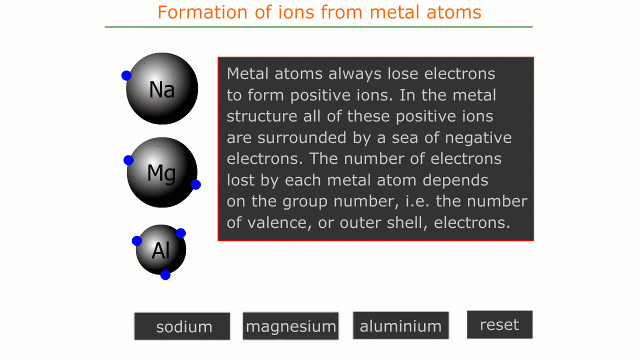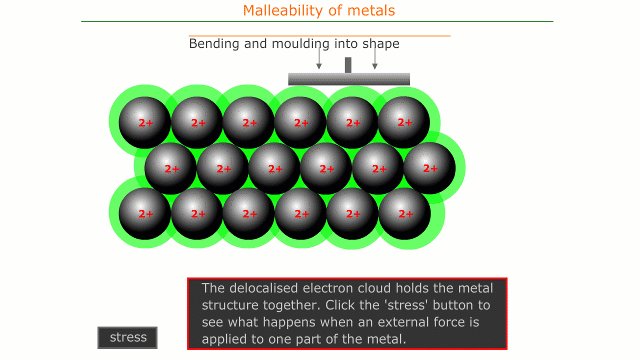Standard level
In this section we examine the forces that hold a metal structure together. The metallic bond.
Syllabus ref: S2.3.1Structure 2.3.1 - A metallic bond is the electrostatic attraction between a lattice of cations and delocalized electrons.
- Explain the electrical conductivity, thermal conductivity and malleability of metals.
Guidance
- Relate characteristic properties of metals to their uses.
Tools and links
- Tool 1, Inquiry 2, Structure 3.1 - What experimental data demonstrate the physical properties of metals, and trends in these properties, in the periodic table?
- Reactivity 3.2 - What trends in reactivity of metals can be predicted from the periodic table?
Delocalisation of electrons
Metal atoms, in common with all other metals apart from the noble gases, cannot exist for very long on their own. Metal atoms aggregate and attract one another in an attempt to stabilise themselves.
Metal atoms have very few electrons in the outer shell (valence electrons) and so cannot achieve a full outer shell by gaining electrons or sharing electrons. They tend to lose electrons, transferring them to non-metal atoms. However, in the absence of non-metal atoms, the only way that they can achieve stability is by sharing all of the outer shell electrons in giant delocalised orbitals. It is these delocalised orbital electrons that give metals their unique characteristics.
Formation of ions
Losing the outer electrons to a large delocalised orbital leaves the metal atoms as ions. These ions are then held in place by the attraction of the negative charge in the delocalised orbital. The ions themselves are arranged in a giant lattice (network).
The charge on the ions depends on the number of outer shell electrons. Group 1 metals provide one electron per atom to the delocalised orbital and the ions formed have a 1+ charge. Group 2 atoms have ions with a 2+ charge.

Transition metals also lose electrons forming ions, but the number of electrons cannot be predicted from the group number (as they are not arranged in groups). Generally transition metals form 2+ ions.
The sea of electrons is a negative charge cloud that attracts all of the positive ions. It is rather like marbles stuck into blu-tack. The metal ions would repel each other without the electron charge cloud, however the force of electrostatic attraction between the electrons and the positive ions holds the whole structure together.
The strength of metallic bonding is a function of the number of electrons provided by the atoms and the consequent charge on the metal ions. The ionic radius also plays a part, as smaller ions exert a greater force of attraction on the negative charge cloud.
- Increasing ionic charge = stronger metallic bonding
- Decreasing ionic radius = stronger metallic bonding
The effect of these two factors can be seen by comparing the melting points (the temperature needed to overcome the forces within the metal structure) down group 1 and across the third period.
| Group 1 metals | Li | Na | K | Rb | Cs |
|---|---|---|---|---|---|
| ionic radius / nm | 0.068 | 0.098 | 0.133 | 0.148 | 0.167 |
| melting point / K | 454 | 371 | 337 | 312 | 302 |
It is clearly seen that as the ionic radius increases so the melting point decreases. Caesium would be a liquid on a warm summer's day.
| Period 3 metals | Na | Mg | Al |
|---|---|---|---|
| ionic radius / nm | 0.098 | 0.065 | 0.045 |
| ionic charge | 1+ | 2+ | 3+ |
| melting point / K | 371 | 922 | 936 |
Although magnesium has a similar radius to lithium, the melting point is far higher, indicating that the effect of doubling the ionic charge is much more significant. Aluminium has a higher melting point than magnesium although not such a diference as between lithium and magnesium. It is thought that the high charge density of the aluminium 3+ ion pulls electron density back onto the aluminium ions effectively decreasing their ionic charge. Aluminium is known to do this in its compounds, giving them a high degree of covalent character, so it seems reasonable that similar effects apply to the metallic bond.
The metallic lattice
As the metal ions in a lattice of a metallic element are all the same radius they can easily pack together like marbles in a bucket.
The most common arrangement is called hexagonal close packing (HCP). It is the most efficient way for spheres to pack close together.
There are two main close packing systems, depending on how the third layer is placed in comparison to the other two. These two packing systems are called ABA and ABC. If the ions of third layer are directly above those of the first layer, it is called ABA. If the ions of the third layer sit in 'holes' that are not directly above any other ion the packing is called ABC. The best way to visualise this is using models.

Electrical conductivity
All metals are conductors; it is the one characteristic that unites them. To conduct means to pass an electrical current and conductivity is a measure of how well a substance can conduct.
Electricity is a flow of electrons from a negative potential to a positive potential. When an electrical potential is applied to two ends of a metal wire, a metal can pass electrons from atom to atom, due to their delocalised electron layers.

In general, metals that have a high ionic charge, or those that easily release electrons are the best conductors.
Thermal conductivity
In general, metals are good conductors of heat energy.
Metals absorb heat as vibrations of the atoms in the structure. The atoms are held together by the delocalised electrons that vibrate in conjunction with the atoms. This allows the vibrations to be passed easily along from atom to atom
The magnitude thermal conductivity depends on the strength of the metallic bonding
Thermal conductivities of some common metals and alloys/ Wm−1 K−1
- Silver: 430
- Copper: 400
- Aluminium: 235
- Brass: 109
Melting point
The melting point of a metal may be used to assess the strength of its interparticular forces. The melting point is a function of the ionic charge on the metal ions in the lattice and their size (radius).
- High charged ions = high melting points
- Small sized ions = high melting points
|
Example: Explain the difference in melting points between the values for sodium (98ºC) and magnesium (667ºC). Sodium from group I forms ions with a single plus charge. Each atom only provides 1 electron to the delocalised electron cloud, responsible for holding the ions together. Magnesium however forms ions with a 2+ charge, each atom providing two electrons to the charge cloud that holds the ions together. An additional factor increasing the lattice strength of magnesium, is the smaller size of its ion compared to that of sodium. The magnesium 2+ ion has a higher charge density and a greater attractive force for the delocalised electron charge cloud. |
There is also a third, more unpredictable factor, which is the actual packing of the metal atoms. Different metals may use one of several different packing schemes, or even a mixture of more than one.
Malleability
Malleable means the ability to bend and stretch without breaking. Metals are generally malleable and can be shaped into almost any form, or drawn into wires (ductility). The reason lies in the microscopic structure of a metal.
Metallic structures are held together by a sea of electrons. This type of bonding is non-directional, i.e. it doesn't act in any specific direction. Consequently, the shape of a metal can be deformed and the structural integrity is maintained. After deformation, the force of attraction still holds all the ions in their new positions in the structure.

Other metallic properties
Metals are usually hard, silvery, shiny, sonorous, and have high melting points.
There are of course many exceptions to these general properties. Lead, for example is difficult to polish into a shine. Mercury is a liquid at room temperature and gallium is very nearly so.
The only reliable metallic property is conductivity.
Worked examples
Q252-01 What are responsible for the high electrical conductivity of metals?- Delocalised positive ions
- Delocalised valence electrons
- Delocalised atoms
- Delocalised negative ions
|
Conductivity is due to delocalised valence electrons |
Q252-02 Which is a correct description of metallic bonding?
- Positively charged metal ions are attracted to negatively charged ions
- negatively charged metal ions are attracted to positively charged metal ions
- Positively charged metal ions are attracted to delocalised electrons
- negatively charged metal ions are attracted to delocalised electrons
|
A metallic structure is a close packed array of positively charged metal ions attracted to delocalised electrons |
